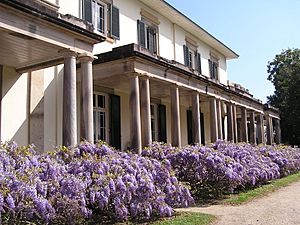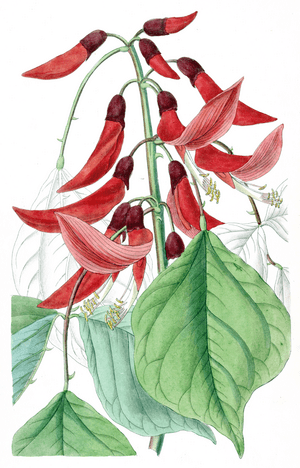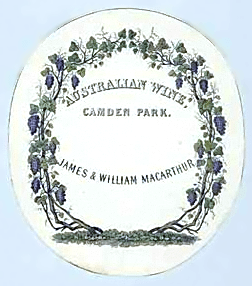Camden Park Estate facts for kids
Quick facts for kids Camden Park Estate and Belgenny Farm |
|
|---|---|

Camden Park House
|
|
| Location | Elizabeth Macarthur Avenue, Camden South, Camden Council, New South Wales, Australia |
| Built | 1819–1840 |
| Built for | John Macarthur |
| Architect |
|
| Owner | Belgenny Farm Trust; Camden Park Preservation Committee |
| Official name: Camden Park Estate and Belgenny Farm; Elizabeth Macarthur Agricultural Institute (EMAI); Menangle Paddock | |
| Type | State heritage (landscape) |
| Designated | 22 December 2006 |
| Reference no. | 1697 |
| Type | Farm |
| Category | Farming and Grazing |
| Builders |
|
| Lua error in Module:Location_map at line 420: attempt to index field 'wikibase' (a nil value). | |
The Camden Park Estate and Belgenny Farm are important historical places in Camden South, New South Wales, Australia. This large working farm was designed by several architects and built between 1819 and 1840. It was started by John Macarthur, a key figure in Australia's early wool industry. Today, parts of the original estate are used by the Elizabeth Macarthur Agricultural Institute. The estate has been a commercial sheep station and farm for the Macarthur family since the early 1800s. It was added to the New South Wales State Heritage Register in 2006.
Contents
A Journey Through Time at Camden Park
When the first European settlers arrived in Sydney in 1788, they found the local soil wasn't great for farming. They soon looked west to the Cumberland Plain for better land. Early farms were set up near rivers like the Nepean and Hawkesbury.
Discovery of the Cowpastures
The first Europeans to explore the Camden area weren't people, but cattle! Some cows escaped from Sydney Cove in 1788. They found their way to the rich grasslands of the Wianamatta Shale region. In 1795, a group sent by Governor Hunter found these stray cattle. They named the area "Cowpastures" because of them. This land was kept for the wild cattle to help their numbers grow.
Meeting the Gandangara People
This area was the traditional home of the Gandangara Aboriginal people. The first recorded meeting between Europeans and Aboriginal people here was in 1802. A French explorer, Francis Barrallier, wrote in his journal that he "met and befriended the Gandangara people."
Later, John Macarthur also met the Gandangara people. Early records show that they "came amongst the settlers familiarly." However, within a few years, Macarthur began using their traditional lands for his sheep.
John Macarthur's Vision
In 1801, John Macarthur went to England. While there, he worked to start a wool industry in the colony. He convinced the British Secretary of State, Lord Camden, to give him more land for his sheep. He also got some merino sheep from King George III's own flocks.
In 1805, Macarthur returned to New South Wales. He received a large land grant of about 2,000 hectares (4,900 acres) from Lord Camden. Macarthur chose the fertile Cowpastures for his new property. He named it "Camden Park" to honour Lord Camden. From then on, he focused on farming and business.
Macarthur's land grew to over 10,900 hectares (27,000 acres) through purchases and exchanges. He controlled a large section of the riverbank where the wild cattle had first found the best pastures.
Early Buildings and Challenges
One of the first things Macarthur built was a small hut on a ridge at Benkennie (Belgenny). It was a simple slab hut with a bark roof. Governor Macquarie visited in 1810 and called it "small and miserable."
From 1809 to 1817, John Macarthur was away from the colony due to his involvement in the "Rum Rebellion" (a time of political unrest). His wife, Elizabeth Macarthur, managed the farm during this time. She lived in the original hut and worked hard to develop food production at Camden Park. By 1813, the sheep flock had grown to over 4,000, and a wool store was built.
Growing the Estate: Farming and Innovation
After returning in 1817, John Macarthur, with his sons James and William, began to make the farm even more productive. They brought in vine cuttings, olive trees, and new seeds from overseas.
Wine and Plants
In 1816, England's Royal Society for the Arts offered medals for wine from New South Wales. The Macarthurs planted grape varieties at Camden Park, and their first wine was made in 1824.
By 1819, a new cottage was built at Belgenny. The family's wool business thrived, bringing in record prices. Belgenny became the main hub for the Camden estate's farming activities.
The estate grew to over 10,000 hectares (25,000 acres) by 1825. They had a dairy with 14 dairymaids and 23 shepherds, showing how many people worked there. In the 1830s, they started orchards, tobacco, and vegetable crops. They even installed a mechanical irrigation system!

The Macarthur family played a huge role in starting the Australian wine industry. Camden Park became famous worldwide for its wine. They imported and shared vine cuttings across New South Wales and even to the Barossa Valley in South Australia. By 1841, William and James were making over 23,000 litres; 6,000 US gallons (5,000 imp gal) of wine, winning gold medals in England. In 1844, they sent 24,000 vine cuttings to Adelaide, helping South Australia become a famous wine region. By 1845, Camden Park was producing around 45,000 litres; 12,000 US gallons (10,000 imp gal) of wine each year!
William Macarthur was also very interested in plants. He introduced and created many new plant types. He published a catalogue of their plants, showing how important their nursery business was. He even sent a hybrid coral tree to London, which is believed to be the first Australian hybrid garden plant published in England.
The estate's orchard and nursery were very important. A single "Gravenstein" apple tree, possibly the oldest surviving apple tree in Australia, remained until recently. A special camellia bush, the "Anemoniflora," still survives at Camden Park House today. It might be the oldest camellia plant in Australia.
Later Developments and Changes
After John Macarthur's death in 1834, his son William took over. He continued to introduce new plants and try new farming methods. He also bought a lot of farm machinery from Europe.
Between 1837 and 1839, a commercial dairy was set up. The Macarthurs brought over 42 families to settle and work at Camden Park. Each family received a small cottage and a quarter-acre block of land.
The large vineyards were later destroyed in the 1870s due to a disease called phylloxera.
By the late 1850s, there were about 160 farms on the estate. The sheep stud (breeding program) became less important, and grain crops became a main product.
In the 1860s, crop diseases led to a decline in grain farming. The estate shifted to mixed farming, including horticulture, wine, and raising cattle and sheep. By 1875, many tenants were asked to leave due to falling prices.
In 1898, a cream separator was installed at Belgenny Farm, and a piggery was built. In the early 1900s, an engine room was added to power farm machinery. The orchard and dairy became the main sources of income.
In 1921, a milk depot was built in Camden. By 1937, Belgenny Farm was mainly used for storing machinery. The working horse stables were even turned into a shearing shed.
In 1952, a special milking machine called the "Rotolactor" was built at Menangle. It was designed to milk 2,500 cows twice a day on a revolving platform! By 1965, Camden Park was known as Australia's largest dairy.
In 1973, much of the land around Belgenny was sold for housing, and the orchard was unfortunately destroyed. However, in 1976, the NSW Government bought back a large part of the land and buildings to protect them. The Camden Park House and its main garden are still owned and farmed by the Macarthur-Stanham family today.
The Estate's Special Features
Camden Park House is a beautiful two-storey building with a grand design. It's made of brick with stone details and has a large verandah and a sandstone entrance. Inside, there are big rooms like the dining room, drawing room, and library. The house also has large cellars, which were used to store the estate's wine.
On a hill facing the house is the family mausoleum, where John and Elizabeth Macarthur and many of their children are buried. It's a peaceful place with exotic Chinese elm trees.
Beautiful Gardens
The gardens around Camden Park are the largest and most complete early colonial gardens in Australia. They were mostly created by Sir William Macarthur, who loved plants and ran a big plant nursery from the estate. Many trees are from the 1800s, including a bauhinia planted by explorer Ludwig Leichhardt. There's also the oldest camellia in the country and unusual jubaea palms.
The gardens offer amazing views of nearby Mount Annan, Mount Gilead, and the church spire of St John's at Camden. The church spire was even designed to be perfectly framed from the house!
Belgenny Farm Buildings
Belgenny Farm was the main headquarters for the Camden Park Estate. It has a collection of old tenant cottages and timber farm buildings. These buildings are important examples of early Australian construction using timber.
Belgenny Cottage was built in stages, with the oldest part dating back to around 1819. John Macarthur lived here until his death in 1834. The original section is made from "brick nog," a very old building method.
Other buildings at Belgenny Farm include the stables (around 1826), the creamery (which was once a coach house), the slaughterhouse, the carpenters' building, and the blacksmith's shop.
A very old English oak tree at Belgenny Farm is believed to be the oldest in Australia. It was supposedly grown from an acorn collected by John Macarthur in 1789. There's also a small vineyard planted to remember the first commercial vineyard and winery in Australia, which started at Camden Park in the 1820s.
Camden Park in Movies
Camden Park House, with its grand looks and gardens, has been used in several films and advertisements:
- The Smiley films (1956, 1958).
- The 1979 movie My Brilliant Career, where it was called Five Bob Downs. Scenes like a formal dinner and a pillow fight were filmed here.
- Julia Leigh's film Sleeping Beauty (2011), starring Emily Browning. Scenes were filmed in the library and along the entrance drive.
Why Camden Park Estate is Special
The Camden Park Estate is very important to the history and culture of New South Wales and Australia. It's a rare and well-preserved example of a large rural estate from the early 1800s. It was also the oldest sheep stud (breeding farm) in Australia.
The estate shows us what life was like on a large farm in the 19th and early 20th centuries. It was a model for other estates of its time. The buildings and landscape are still very much intact, making it a unique historical site.
It's also special because of its strong connection to the Macarthur family, who have owned and lived on the land from John and Elizabeth Macarthur's time right up to the present day.
By the 1830s, the estate was one of the biggest and most advanced mixed farms in New South Wales. It played a huge part in Australia's wool industry, helping Australian wool become popular in Britain.
The estate's gardens have a major collection of plants, and its farm buildings are important because they are old and well-preserved. The orchard and cottages were part of an early commercial plant collection that helped horticulture in New South Wales and other colonies.
Camden Park was vital to the early Australian wine industry. It imported and shared vine cuttings, helping to establish vineyards across the country. The Macarthurs were very innovative. They brought in skilled workers from overseas, installed Australia's first irrigation system in 1830, and pioneered methods for drying fruit. They grew many different types of fruits, nuts, and grapes.
The Camden Park garden and nursery are historically important for showing how estate gardens were designed in the early 1800s. They also show the introduction and growth of many exotic plants in early Australia.
Overall, Camden Park Estate and Belgenny Farm are significant because they are the oldest, most intact rural landscape and group of farm buildings in Australia. They were crucial in developing the country's agriculture, farming, gardening, and wine industries. They also have important links to key figures in New South Wales history, especially John and Elizabeth Macarthur.


